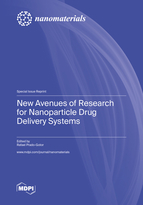New Avenues of Research for Nanoparticle Drug Delivery Systems
A special issue of Nanomaterials (ISSN 2079-4991). This special issue belongs to the section "Biology and Medicines".
Deadline for manuscript submissions: closed (30 June 2021) | Viewed by 36242
Special Issue Editor
Interests: DNA-NPs; proteins-NPs interactions; thermodynamics; kinetics and ligand-ligand interactions
Special Issues, Collections and Topics in MDPI journals
Special Issue Information
Dear Colleagues,
The understanding of the different factors that control the correct procedure for drug loading and nanoparticle drug delivery systems is having a significant impact on many scientific fields, particularly in medicine, chemistry, biology, material science and molecular biotechnology. Not only the election of the correct nanoparticle, the interaction with the biological system or the study of the liberation mechanism is needed to be perfectly understood. In order to well design nanoparticle drug delivery agents a high drug-to-nanoparticle ratio must be achieved. Also, biocompatibility and control of release kinetics are key factors for the design of NP as drug delivery vectors.
Today, efforts on the development of appropriate nanosystems are focused in producing new materials that release drugs in a sequential manner with different therapeutic efficacy. To achieve optimal results among researchers from various areas this Special Issue of Nanomaterials will try to consider all of these key factors that may be taken into account for nanosystems to be suitable for drug release. We invite authors to contribute original research articles or comprehensive mini-review articles covering new synthesis and selection type of NP, drug loading into NPs, stability and new results for in vitro and in vivo studies in order to use NP as efficient drug delivery systems.
Prof. Dr. Rafael Prado-Gotor
Guest Editor
Manuscript Submission Information
Manuscripts should be submitted online at www.mdpi.com by registering and logging in to this website. Once you are registered, click here to go to the submission form. Manuscripts can be submitted until the deadline. All submissions that pass pre-check are peer-reviewed. Accepted papers will be published continuously in the journal (as soon as accepted) and will be listed together on the special issue website. Research articles, review articles as well as short communications are invited. For planned papers, a title and short abstract (about 100 words) can be sent to the Editorial Office for announcement on this website.
Submitted manuscripts should not have been published previously, nor be under consideration for publication elsewhere (except conference proceedings papers). All manuscripts are thoroughly refereed through a single-blind peer-review process. A guide for authors and other relevant information for submission of manuscripts is available on the Instructions for Authors page. Nanomaterials is an international peer-reviewed open access semimonthly journal published by MDPI.
Please visit the Instructions for Authors page before submitting a manuscript. The Article Processing Charge (APC) for publication in this open access journal is 2900 CHF (Swiss Francs). Submitted papers should be well formatted and use good English. Authors may use MDPI's English editing service prior to publication or during author revisions.
Keywords
- Nanoparticle synthesis
- Drug loading Nanoparticle drug release
- Delivery vectors
- Nanoparticles accumulation
- Drug bioavailability
- Nanomedicine







